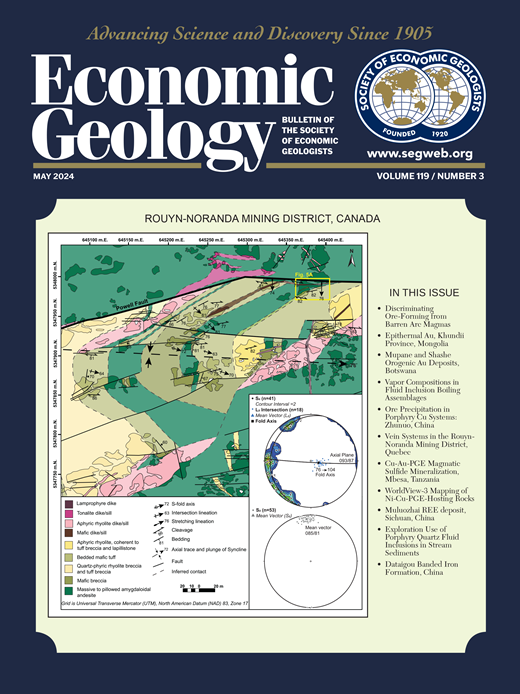Geology and Structural Evolution of the La Huifa Ore Deposit, Central Chile: A Newly Discovered Porphyry Cu-Mo System in the El Teniente District
IF 5.5
1区 地球科学
Q1 GEOCHEMISTRY & GEOPHYSICS
引用次数: 0
Abstract
La Huifa is a breccia-related Cu-Mo porphyry deposit located in the Andes of central Chile, 3 km northeast of the giant El Teniente porphyry Cu-Mo orebody. It was discovered as part of Codelco’s brownfield exploration activities in the El Teniente district. It is the first major discovery in the area, and this work presents its first detailed geologic description. The La Huifa orebody is related to a complex of late Miocene diorite and granodiorite intrusions and hydrothermal breccias, the latter characterized by abundant tourmaline-anhydrite cement, emplaced in middle to late Miocene volcanic and subvolcanic rocks. The structural architecture of La Huifa is dominated by WNW-and NE-striking high angle faults. Usually, slip on the WNW-striking faults involves a sinistral component, whereas slip on the NE-striking faults is predominantly dextral. The main hydrothermal breccia body at La Huifa is located at the intersection of WNW- and NE-striking faults. Four stages are proposed for the tectono-magmatic-hydrothermal evolution of La Huifa:Premineralization, involving tourmaline-albite veins and sodic calcic alteration emplaced under a transpressive tectonic regime with a subhorizontal, ~E-W–trending σ1 (~N-S–trending σ3);Early mineralization, involving a polydirectional vein system associated with poorly developed potassic and transitional alteration zones with a scarce presence of Cu and Mo sulfides;Main mineralization, involving Cu- and Mo-rich anhydrite-tourmaline hydrothermal breccias and polydirectional veins associated with strong chlorite-sericite alteration with a 270° to 290°C emplacement temperature, obtained from chlorite geothermometry. The regional stress field during this period was exceeded by the local fluid pressure. These breccias and veins are followed by the emplacement of NE-striking C and D type veins associated with gray and white sericite alteration, respectively, which show a similar temperature range.Late mineralization, involving a NE-striking, carbonate-rich vein system containing polymetallic sulfides. It is associated with argillic alteration, whose temperature was 200° to 260°C. This stage occurred under a compressive tectonic regime with NE-trending σ1. The relatively low temperature at which mineralization was introduced in this deposit (~270°–290°C) and the predominantly vertical fluid flow pattern typical of hydrothermal breccia systems allow us to infer the presence of more mineralized rock at depth, below the recognized portion of the system. The association of Cu and Mo enrichment with chlorite-sericite alteration, instead of higher-temperature potassic or gray sericite alteration events, makes La Huifa a unique case among the porphyry deposits of central Chile and broadens the scope of mineralization styles that could be targeted in this belt. Finally, the intersection of arc-oblique, high-angle faults and, in particular, the presence of fault systems orthogonal to the main compression direction, favorable for magma storage and differentiation and metal concentration, constitute a valuable tool for exploring porphyry Cu deposits in similar geologic contexts.智利中部La Huifa矿床地质与构造演化:El Teniente地区新发现的斑岩Cu-Mo体系
La Huifa是一个角砾岩型铜钼矿床,位于智利中部安第斯山脉,位于El Teniente斑岩型铜钼矿体东北3公里处。这是Codelco在El Teniente地区棕地勘探活动的一部分。这是该地区的第一个重大发现,这项工作首次提供了详细的地质描述。拉会发矿体与晚中新世闪长岩、花岗闪长岩侵入体和热液角砾岩杂岩有关,后者以丰富的电气石硬石膏胶结物为特征,侵位于中晚中新世火山岩和次火山岩中。拉惠法构造构造以西北西向和北东向高角断裂为主。通常,西北西向断层的滑动涉及左向分量,而北东向断层的滑动主要是右向分量。拉惠发热液角砾岩主体位于西北西向与北东向断裂的交汇处。拉会发的构造-岩浆-热液演化可分为四个阶段:成矿前阶段,包括电气石-钠长石脉和钠钙蚀变,位于逆压构造体制下,次水平,~ e- w走向σ1 (~ n - s走向σ3);成矿早期阶段,包括多向脉系,钾质不发育,过渡性蚀变带,Cu和Mo硫化物较少;含富铜、富钼硬石膏-电气石热液角砾岩和多向脉,伴强烈绿泥石-绢云母蚀变,侵位温度270°~ 290°C。这一时期的区域应力场被局部流体压力所超越。在角砾岩和脉体之后,分别有ne向的C型脉体和D型脉体,它们与灰色绢云母蚀变有关,显示出相似的温度范围。晚期成矿作用,包括北东向、富含碳酸盐的脉系,含多金属硫化物。与泥质蚀变有关,温度为200 ~ 260℃。这一阶段发生在北东走向σ1的挤压构造制度下。该矿床成矿的温度相对较低(~270°-290°C),以及典型的热液角砾岩系统的主要垂直流体流动模式,使我们能够推断在该系统可识别部分以下的深度存在更多的矿化岩石。铜和钼的富集与绿泥石-绢云母蚀变有关,而不是与高温钾质或灰色绢云母蚀变有关,这使得拉惠法在智利中部斑岩矿床中成为一个独特的案例,并拓宽了该带的成矿风格范围。斜弧高角度断裂的交汇,特别是与主挤压方向正交的断裂体系的存在,有利于岩浆的储存、分异和金属的富集,是在类似地质背景下寻找斑岩型铜矿床的重要工具。
本文章由计算机程序翻译,如有差异,请以英文原文为准。
求助全文
约1分钟内获得全文
求助全文
来源期刊

Economic Geology
地学-地球化学与地球物理
CiteScore
10.00
自引率
6.90%
发文量
120
审稿时长
6 months
期刊介绍:
The journal, now published semi-quarterly, was first published in 1905 by the Economic Geology Publishing Company (PUBCO), a not-for-profit company established for the purpose of publishing a periodical devoted to economic geology. On the founding of SEG in 1920, a cooperative arrangement between PUBCO and SEG made the journal the official organ of the Society, and PUBCO agreed to carry the Society''s name on the front cover under the heading "Bulletin of the Society of Economic Geologists". PUBCO and SEG continued to operate as cooperating but separate entities until 2001, when the Board of Directors of PUBCO and the Council of SEG, by unanimous consent, approved a formal agreement of merger. The former activities of the PUBCO Board of Directors are now carried out by a Publications Board, a new self-governing unit within SEG.
 求助内容:
求助内容: 应助结果提醒方式:
应助结果提醒方式:


